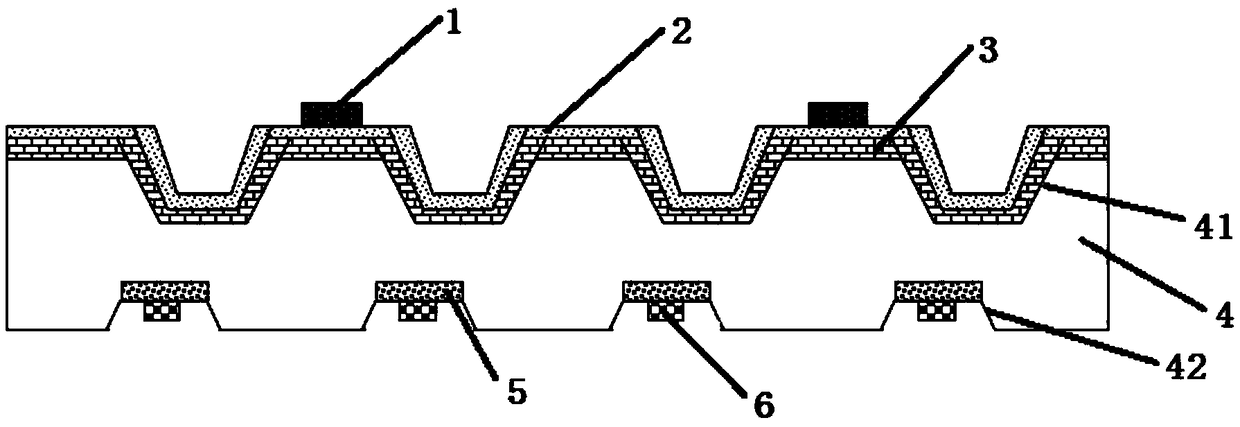A silicon-based organic-inorganic hybrid solar cell and a preparation method thereof
A solar cell and inorganic technology, applied in the field of solar cells, can solve the problems of no significant improvement of organic solar cells, environmental risks, high manufacturing costs, etc., achieve excellent photoelectric conversion efficiency, improve film-forming performance and conductivity, and optimize The effect of the way
- Summary
- Abstract
- Description
- Claims
- Application Information
AI Technical Summary
Problems solved by technology
Method used
Image
Examples
preparation example Construction
[0028] The present invention proposes a method for preparing a silicon-based organic-inorganic hybrid solar cell, comprising the following steps:
[0029] 1) Provide an N-type single crystal silicon wafer, clean the N-type single crystal silicon wafer, then form a plurality of first grooves arranged in parallel and spaced apart on the upper surface of the N-type single crystal silicon wafer, and then The lower surface of the N-type single crystal silicon wafer forms a plurality of second grooves arranged in parallel and arranged at intervals, the cross-sections of the first groove and the second groove are both isosceles trapezoidal, and the plurality of The first groove corresponds to a plurality of the second grooves respectively, and the first groove and the corresponding second groove partially overlap in the vertical direction, and the bottom surface of the first groove and the second groove are partially overlapped in the vertical direction. The thickness between the bot...
Embodiment 1
[0044] A method for preparing a silicon-based organic-inorganic hybrid solar cell, comprising the following steps:
[0045] 1) Provide an N-type single crystal silicon wafer, clean the N-type single crystal silicon wafer, then form a plurality of first grooves arranged in parallel and spaced apart on the upper surface of the N-type single crystal silicon wafer, and then The lower surface of the N-type single crystal silicon wafer forms a plurality of second grooves arranged in parallel and arranged at intervals, the cross-sections of the first groove and the second groove are both isosceles trapezoidal, and the plurality of The first groove corresponds to a plurality of the second grooves respectively, and the first groove and the corresponding second groove partially overlap in the vertical direction, and the bottom surface of the first groove and the second groove are partially overlapped in the vertical direction. The thickness between the bottom surfaces of the correspondi...
Embodiment 2
[0060] A method for preparing a silicon-based organic-inorganic hybrid solar cell, comprising the following steps:
[0061] 1) Provide an N-type single crystal silicon wafer, clean the N-type single crystal silicon wafer, then form a plurality of first grooves arranged in parallel and spaced apart on the upper surface of the N-type single crystal silicon wafer, and then The lower surface of the N-type single crystal silicon wafer forms a plurality of second grooves arranged in parallel and arranged at intervals, the cross-sections of the first groove and the second groove are both isosceles trapezoidal, and the plurality of The first groove corresponds to a plurality of the second grooves respectively, and the first groove and the corresponding second groove partially overlap in the vertical direction, and the bottom surface of the first groove and the second groove are partially overlapped in the vertical direction. The thickness between the bottom surfaces of the correspondi...
PUM
 Login to View More
Login to View More Abstract
Description
Claims
Application Information
 Login to View More
Login to View More - R&D
- Intellectual Property
- Life Sciences
- Materials
- Tech Scout
- Unparalleled Data Quality
- Higher Quality Content
- 60% Fewer Hallucinations
Browse by: Latest US Patents, China's latest patents, Technical Efficacy Thesaurus, Application Domain, Technology Topic, Popular Technical Reports.
© 2025 PatSnap. All rights reserved.Legal|Privacy policy|Modern Slavery Act Transparency Statement|Sitemap|About US| Contact US: help@patsnap.com

